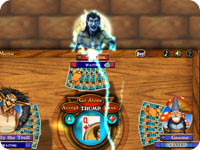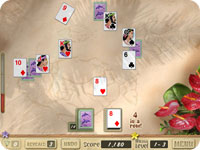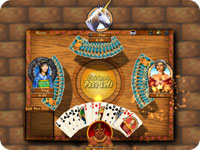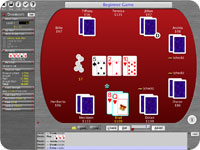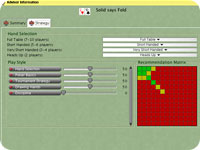A Brief Look at the History of Card Games
With the need for entertainment deeply ingrained in our genetic make-up, it’s not a surprise that the history of card games stretches centuries into the murky past. Obviously, the invention of paper was a prerequisite for the creation of the first playing cards as we more or less know them today, but given the lack of record-keeping prior to the written word, it’s always possible that people scratched markings on leaves or other items and played games with them.
However, we’ll stick with the origins of the analog versions of the games you just read about. They likely started in China, not long after the invention of paper. In fact, there’s evidence that early playing cards doubled as currency. Those creations also featured designs that were later incorporated into Mahjong tiles and the Chinese version of dominoes. In 969, the Emperor Msu-tsung was said to have played “domino cards” with his spouse, a moment underlining that shared history.
Chinese playing cards had suits known as coins, strings of coins, myriads of strings, and tens of myriads, with 33 cards comprising a deck. It’s possible that some decks of Chinese cards made their way to Europe and had some influence on their Western counterparts. Specimens also probably showed up in Persia, where they held sway over the cards that showed up in Europe during the late 1300s. Those cards came from Egypt via the Mamelukes, slave soldiers who had assumed a position of power by that time.
It’s likely the Mameluke cards were also influenced by the Indian card game known as Ganjifa, which used circular cards that had 8 to 12 suits, each containing 10 number cards and two court cards (i.e., the equivalent of kings, queens, and jacks). That game became Ganjifeh in Persia, and Kanjifah in Arabia; the latter term was found on a Mameluke card made around 1400, a piece of evidence that further strengthens the connection.
Like the playing cards of today, the Mameluke decks used in Europe had 52 cards, but they employed different suits: polo sticks, coins, swords, and cups. Each suit contained numbered cards 1 through 10, identified by the number of symbols on them, as well as three cards representing royalty: king, viceroy, and under-deputy. The royalty cards tended to have abstract designs on them, along with the names of actual military officers.
Cards become popular in Europe
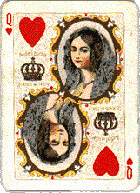
Playing cards spread quickly throughout Europe from 1371 on, with many of them carved into pieces of wood so the designs could be pressed onto paper. Europeans also experimented with changes to the royalty cards, calling them king, chevalier, and knave but later replacing the king with a queen in some of the suits.
Some people produced 56-card decks, with each suit containing a king, queen, knight, and valet, and it was common for the names of the suits to change. For example, the Swiss used shields, flowers, bells, and acorns, while the Germans chose hearts, leaves, bells, and acorns. Various kinds of animals, birds, fish, utensils, and other objects appeared in other places.
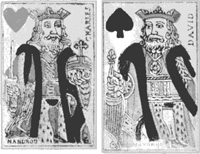
The traditional hearts, diamonds, spades, and clubs suits made their appearance in France around 1480, when the 52-card deck became standard. Those suits were chosen because it was easier to stencil the designs onto the cards, rather than carve them in pieces of wood. The French also took to naming their royalty cards after historical figures, such as David, Alexander, Caesar, and Charlemagne for the kings. All of those traits were popularized in the cards produced in the city Rouen, which exported a good chunk of its output to England, thus heavily influencing the cards produced there.
By the late 1400s, some players in Europe began putting special emphasis on the ace card, placing it above the king and making the two card the lowest. The concept became very popular during the French Revolution in the late 1700s, when players saw it as a symbol of the common man rising above royalty.
Shuffling the card designs
The three royalty cards were known as king, queen, and knave through the 1600s, when some players started calling the knave the jack, after the term for the knave of trumps in the game All Fours. However, All Fours was often considered a lower-class game, so some players stayed with the original term, which finally died in the 1800s when the concept of corner-placed card names (such as “J ♣” or “3 ♦”) appeared.
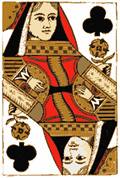
Placing a card’s name in its corner enabled players to hold their cards in one hand, rather than two, but the abbreviation for knave (“kn”) was often confused with the “k” used for king, a trend that accelerated the adoption of the word “jack.” Players also received help from the concept of reversible royalty cards, which showed the same picture no matter which way they were held. Previously, royalty card portraits ran in only one direction, which tipped off opponents when players turned them so they were right-side up.
America initiated the final change that made playing cards what they are today, adding two jokers to the deck for the game of euchre around 1850. The cards made their way to Europe along with the game of poker, where jokers are sometimes used as wild cards.
The game’s the thing
Card games proliferated and changed as frequently as the cards themselves did, growing from the 35 documented by Renaissance writer Francois Rabelais in 1534 to the hundreds that exist today, as documented at one website. Even the game broadly known as solitaire has dozens of variants, as seen in Hardwood Solitaire III, which features 101 of them.
In addition, plenty of card games exist that don’t use the traditional deck. Uno, for example, uses a custom deck of 108 cards, and if you’ve played Star Wars: Knights of the Old Republic, then you’ve experienced the Blackjack-like card game known as Pazaak.
Star Wars fans have also probably heard of Sabacc, another Blackjack-like game that’s famous as the one Han Solo played when he won the Millennium Falcon from Lando Calrissian. Other games set in fictional universes include Cripple Mr. Onion (Terry Pratchett’s Discworld novels), Diamondback (the Cerebus comic book series), Double Fanucci (the Zork computer games), Dragon Poker (the MythAdventures novels), Fizzbin (the original Star Trek TV series), Pyramid (Battlestar Galactica, new and old) and Tall Card (the Firefly TV series). The card games page at Wikipedia features more information about most of them, including rules invented by fans.
Finally, 1993 saw the introduction of a sub-genre known as collectible card games, the first of which was Magic: The Gathering. These games combine strategy with the ability to build a custom deck by purchasing packs of cards and looking for rare ones offering the best bonuses. Some use unique concepts while others are based on well-known properties, such as Star Wars, The Lord of the Rings, and even Major League Baseball.

